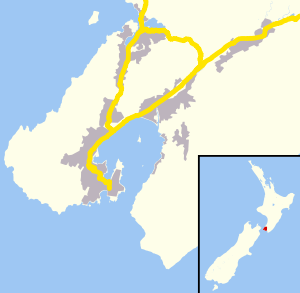Ohariu, New Zealand
Ohariu (or Ohariu Valley) is a suburb of Wellington, New Zealand. It is a rural area, located 5 kilometres (3.1 mi) from Khandallah.
Ohariu | |
|---|---|
Suburb | |
 Ohariu  Ohariu | |
| Coordinates: 41°13′25″S 174°44′38″E | |
| Country | New Zealand |
| Local authority | Wellington City |
| Electoral ward | Onslow-Western Ward |
| Area | |
| • Land | 15,193 ha (37,543 acres) |
| Population | |
| • Total | 783 |
|
|
||
The name is a corruption of Owhariu, where, according to Māori mythology, Kupe dried the sails of his canoe.[2] The area is governed by the Mākara / Ohariu Community Board.[3]
The name of the locality has given its name to two general electorates: Ōhāriu (first formed for the 1978 election without macrons) and Ohariu-Belmont (which existed from 1996 to 2008).[4]
History
In the 19th century, Ohariu was divided into Country Sections by the New Zealand Company. Many were sold to absentee owners, and there were only three resident settlers in 1854: James Smith, James Hallett and James Holder. Later settlers from the 1860s were James Bryant and his sons of Huia Farm, Thomas Bassett of Willow Bank, Charles Austin, George Best, and George Beech. Initially farms ran sheep and beef cattle.
Access was by tracks from Awarua Street (Ngaio), Khandallah and Johnsonville; from the 1860s by the Old Coach Road, and in 1908 via Ironside Road to Johnsonville.[5]
From 1916 there was a dairying invasion which lasted fifty years, because of a better return than from sheep. It began when Frank Nossiter bought Alf Kirby's 100 acre (41 ha) sheep farm, and moved 25 cows from Fielding to his Catewell Farm. He was joined by a dozen more dairy farmers.[6]
Ohariu Valley has an article from 1896 in The Cyclopedia of New Zealand.[7]
Further reading
- Bremner, Julie (1983). Wellington’s Northern Suburbs 1840-1918. Wellington: Millwood Press. pp. 87–92. ISBN 0-908582-59-5.
- Bremner, Julie (1987). Wellington’s Northern Suburbs 1919-1945. Wellington: Millwood Press. ISBN 0-908582-80-3.
References
- "Community profile - Ohariu". Wellington City Council.
- Reed, A. W. (2010). Peter Dowling (ed.). Place Names of New Zealand. Rosedale, North Shore: Raupo. p. 280. ISBN 9780143204107.CS1 maint: ref=harv (link)
- "Makara / Ohariu Community Board". Wellington City Council. Retrieved 3 October 2014.
- "Ōhāriu: Electoral Profile" (PDF). Parliamentary Library. September 2014. Retrieved 3 October 2014.
- Bremner, Julie (1983). Wellington’s Northern Suburbs 1840-1918. Wellington: Millwood Press. pp. 87–92. ISBN 0-908582-59-5.
-
- Bremner, Julie (1987). Wellington’s Northern Suburbs 1919-1945. Wellington: Millwood Press. p. 99. ISBN 0-908582-80-3.
- "Ohariu Valley, 1896". Cyclopedia of New Zealand. 1896.